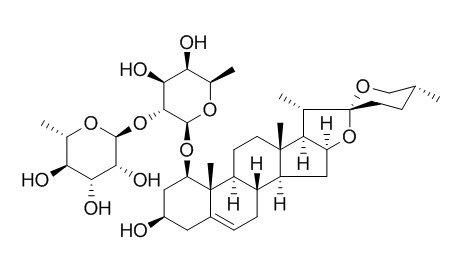Natural Products
Ophiopogonin B
| Catalog No. | CFN98555 |  |
| CAS No. | 38971-41-4 | |
| Molecular Weight: | 722.91 | |
| Molecular Formula | C39H62O12 | |
| DBs | [PubChem]:274951946 [ChEMBL]:80879 [PCIDB]: |
Standard InChI:
InChI=1S/C39H62O12/c1-17-9-12-39(46-16-17)18(2)28-26(51-39)15-25-23-8-7-21-13-22(40)14-27(38(21,6)24(23)10-11-37(25,28)5)49-36-34(32(44)30(42)20(4)48-36)50-35-33(45)31(43)29(41)19(3)47-35/h7,17-20,22-36,40-45H,8-16H2,1-6H3/t17-,18+,19+,20-,22-,23-,24+,25+,26+,27-,28+,29+,30+,31-,32+,33-,34-,35+,36+,37+,38+,39-/m1/s1
Biological Activity
Ophiopogonin B (OP-B) is a bioactive component of Radix Ophiopogon Japonicus, which is often used in Chinese traditional medicine to treat pulmonary disease, it is a prospective inhibitor of PI3K/Akt and may be used as an alternative compound to treat NSCLC, it also induces apoptosis, mitotic catastrophe and autophagy , has inhibitory effect on adhesion, invasion and migration of A549 cells in vitro.[1-3]
Ophiopogonin B increases the protein expression levels of caspase-3 and B-cell lymphoma 2 (Bcl-2)-associated X protein, whereas the expression levels of Bcl-2 and the phosphorylation levels of extracellular signal-regulated kinases 1/2 and c-Jun N-terminal kinases 1/2 were decreased suggests that it may be considered a potential inhibitor of gastric cancer progression, and may be used as an alternative compound for its treatment.[4]
Product
References
[1] Chen M, Du Y, Qui M, et al. Oncol Rep, 2013, 29(2):430-6.
[2] Chen M, Guo Y, Zhao R, et al. Int J Oncol, 2016,49(1):316-24.
[3] Chen M J, Zhao R L, Guo Y Y, et al. Chinese Pharmacol Bull, 2015, 31(5):660-4.
[4] Zhang W, Zhang Q, Jiang Y, et al. Mol Med Rep, 2016, 13(6):4981-6.
[5] Wu T, Yu B Y, Cheng Z H , et al.Chinese herbal medicine, 2000, 31 (03): 175-7.
Product Use Citation





